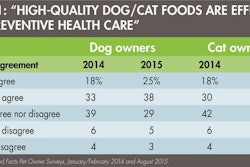If you’re a pet food manufacturer, the US Food and Drug Administration (FDA) wants to be your friend. OK, that might be something of an overstatement, but it was the gist of the message delivered by Scott MacIntire, director of FDA’s Division of Enforcement/Office of Enforcement and Import Operations within the Office of Regulatory Affairs, to pet food and feed professionals attending the 2015 Feed and Pet Food Joint Conference September 29-October 1 in Columbus, Ohio, USA.
Essentially, MacIntire emphasized that the underlying philosophy for his division’s enforcement of the Food Safety Modernization Act (FSMA) is to try and change the culture in FDA from one of enforcement only to working with industry to gain compliance. The foundation for this change, he said, is the FDA Program Alignment Initiative, announced in February 2014, that set out to develop vertically integrated, “commodity” (industry)-specific programs, with specialized inspectors, compliance staff and regulatory staff for each program. The intent of the initiative was to establish “clear, current, consistently applied technical/operational policy; clear roles, responsibilities and streamlined decision making; risk-based allocation for program resources; and agreed-upon performance/public health metrics,” MacIntire said.
Enforcement of FSMA will fall under this initiative, which signifies a major difference in how FDA operates, thanks to the specialization of inspection and compliance functions and to investigators and subject matter experts working together to drive correction of problems, MacIntire added. Other key components include an investment in regulator training to promote consistent inspections and decision making, plus continual outreach to industry via guidance documents, education and training, alliances and technical assistance networks.
FDA has already made good on some of these promises. For example, it is developing guidance documents for the animal feed preventive control rule under FSMA. It has also established a Food Safety Preventive Controls Alliance that is developing training for industry as well as regulators. Food and feed safety staff from FDA will be required to attend the training, and industry members who complete the training will receive a certificate, which will count under FSMA, MacIntire said. The preventive controls training will take three to four years because of the sheer number of people needing training, he added.
In addition, the agency has formed a Food Safety Technical Assistance Network to provide central, consistent sources of outreach and real-time technical assistance to industry and regulators before, during and after inspections. Training for that is also under way.
“When inspectors knock on your door and say, ‘Hi, we're here to help you,’ they'll really mean it!” MacIntire said. While his remark elicited chuckles from the Feed and Pet Food Joint Conference audience, he insisted it wasn’t a joke. In the same vein, he wants FDA staff at all levels—field staff, state offices, officers in Washington, DC—to have an open-door policy with industry.
This new culture also includes giving recognition of some sort to facilities for self-identifying problems and fixing them, and coming up with different ways to address things, MacIntire said, adding that he would like to hear from industry about what type of incentives might be appropriate. The implementation of FSMA will encourage industry to comply and make corrections on its own, including timely, adequate corrective actions, Macintire believes; but if that doesn't happen, then there will be “swift” consequences, which his office has not yet defined.
Specific to the recently finalized animal feed preventive control rule—and perhaps of most interest to pet food manufacturers—MacIntire said FDA will not use a one-size-fits-all approach, because of the flexibility designed into the rule. So, that may mean the agency and its inspectors will spend less time in facilities with very good safety records and more time in ones that need more help.
Further, the agency is aiming for systems-based inspections, not “observation focused” ones, and for interactive, cooperative inspections that include “open, constructive dialogue with a firm’s employees during inspections,” MacIntire said. “The intent is to educate while we regulate.”
Finally, he emphasized that FDA’s new initiative seeks a regulatory strategy that is dynamic, meaning that “different violations trigger different regulatory response; there are different industry timeframes for corrective actions; and different timeframes for FDA or state verification.
“This is a big initiative within FDA. We can't fall on our face,” MacIntire added. Indeed. Nor can the pet food industry (or the feed and human food industries, also affected by FSMA) afford for FDA to get it wrong.
Is a change in culture the way for FDA to ensure it gets FSMA right? Is a large, governmental agency such as FDA even capable of changing its culture? And, will current, wholly inadequate funding levels for FSMA remain, making all of this completely moot? The next year should prove pretty interesting in terms of pet food safety.
















